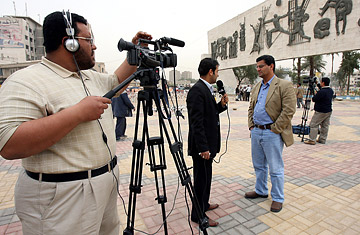
An Iraqi reporter interviews an Iraqi man in central Baghdad on March 11, 2008.
TIME's World Editor, Bobby Ghosh, was the longest serving print journalist in Iraq until he moved to New York City six months ago. On the eve of the anniversary, Ghosh returned to Baghdad to write a follow-up piece to his 2006 cover story, Life in Hell.
On his latest assignment in Iraq
My trip has a very simple purpose. I'm tired of reading how the surge has brought violence down. Has it succeeded? Has it not succeeded? I think we need to look past the statistics to get a sense of what Baghdad feels like. So what I'm going to try to do with my story is apply some personal litmus tests to the surge. Can I go to the restaurants I grew very fond of in Baghdad that I could visit two and a half years ago? Can I go to the markets, the shops that I used to go to? Can I go to and visit friends in their homes without endangering them — foreigner coming to the neighborhood? Can I take a boat ride down the Tigris? Can I go to the street and buy books from the second-hand book market. Are my friends still there? Many of them had fled to Jordan this year. Are they coming back? Those who remained, are they more hopeful of their future? I want to get a very tactile and textured sense of what life is like in Baghdad now. Two years ago I wrote a cover story entitled Life in Hell which served its exact purpose to get a sense of what life feels like in the city. This is part two of that. I want to find out what it feels like.
On covering the war's launch
I arrived in Baghdad on the day the statue came down. Some of us who had been there before the war started were kicked out during the war. So I came back and the city was still in a state of shock. People realized that something important and profound had happened but they'd gone through so many disappointments before that they couldn't really come out and celebrate. So you had all these images on television of the flag being hoisted on top of the statue, the statue being pulled down, and some people in that square celebrating, but most of the city was very quiet. It was almost eerie. The first thing I did was look for friends of mine who I had known from before the war. These are people who lived for years in a state of terror, a state of fear. That was living in Saddam Hussein's Iraq. They had become so used to hiding their feelings and watching their words that it took them a while even after Saddam was gone to express themselves properly.
On the reaction to American military presence
The first weeks after the war were incredible. Once people got over the shock, once they had come to terms with the idea that Saddam Hussein was really gone, was not coming back, the sight of American soldiers in the streets, at checkpoints, American tanks and armor rumbling along the city. That was reassuring. In the months and years to come, those would be seen as signs of oppression and occupation. But for those first few weeks, these were reassuring signs. It meant that if there were American tanks in front of the presidential palace, that meant the president was not coming back.
On the looting and fires
In the immediate aftermath of the fall, some people expressed themselves by going and looting every government building that they could find. There was a lot of outrage and horror at this internationally, but I could understand where these people were coming from. I think they felt that this was their opportunity to take from the government. Yes, there was some basic criminal urge with some people, but for a lot of people it was a sense of vengeance. They couldn't get their hands on Saddam Hussein. They couldn't get their hands on the Baath party commanders who had oppressed them for so long, so they would steal the furniture. They would take the air conditioning. They would set fire to government buildings. It was their way — in a sort of peculiar way — it was a form of protest.
